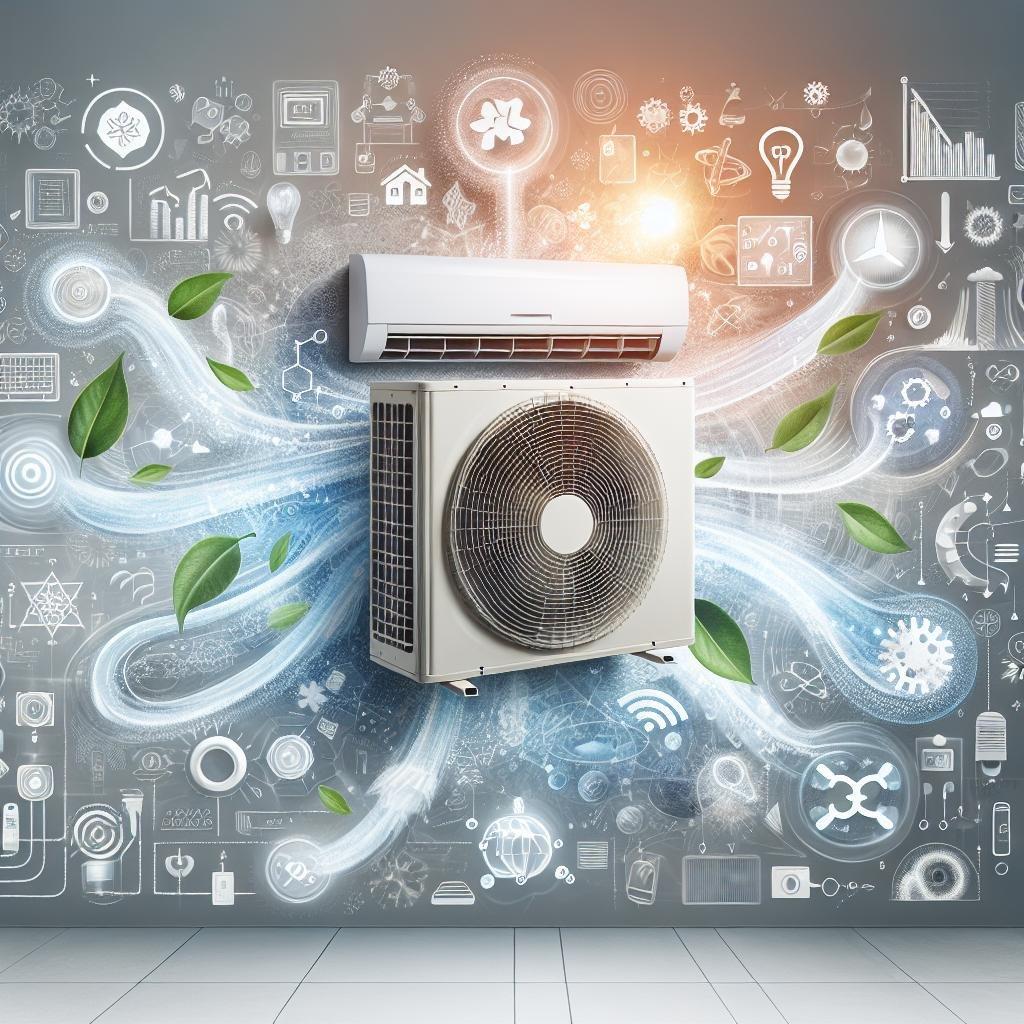As the temperatures rise and the sun blazes down, commercial spaces—whether bustling offices, inviting cafes, or expansive retail stores—face the pressing challenge of maintaining a cozy environment for employees and customers alike. Efficient air conditioning is not merely a luxury; it’s a vital component of productivity and customer satisfaction. In the world of business, where every detail matters, ensuring that your cooling systems operate optimally can lead to notable savings and improved comfort. This article delves into essential tips and tricks for optimizing air conditioning in commercial spaces,offering practical insights that blend innovation with energy efficiency. From smart technology solutions to routine maintenance practices, discover how to keep your environment not only cool but also cost-effective and environmentally friendly.Join us as we explore the pathways to creating a refreshing haven amidst the heat.
Maximizing Energy Efficiency Through Strategic Airflow Management
Effective air distribution is crucial for enhancing energy efficiency in commercial spaces. By optimizing airflow management, businesses can significantly reduce energy consumption while ensuring a comfortable environment. One of the foundational strategies is to position air vents and diffusers strategically to promote even cooling throughout the space. This involves assessing room layouts and identifying high-traffic areas that may require additional cooling or adjustments in airflow direction. Regular maintenance, including the cleaning of filters and ducts, also plays a vital role in maintaining optimal airflow, which can prevent obstructions that may hinder performance.
Another key element is utilizing smart technology to monitor and regulate air circulation. Implementing programmable thermostats and zoning systems allows for more precise control over temperature settings in different areas of the building, leading to more efficient cooling practices. Additionally, integrating ceiling fans can assist in redistributing cooled air, creating a better overall climate while consuming less energy. Below is a simple overview of effective strategies for managing airflow:
| Strategy | Description |
|---|---|
| Strategic Vent Placement | Position vents to direct airflow efficiently throughout the space. |
| Regular Maintenance | Clean filters and ducts to ensure unobstructed airflow. |
| Smart Technology | Use programmable thermostats for better control and efficiency. |
| Ceiling Fans | Enhance air circulation and reduce reliance on AC. |

Choosing the Right Air Conditioning System for Your Commercial Space
When selecting an air conditioning system for a commercial space,it’s essential to consider various factors that align with your business’s unique requirements. Begin by assessing the size and layout of your space, as larger areas may necessitate multiple units or a centralized system to ensure uniform cooling. Additionally, the type of business can impact the choice of system; for instance, a restaurant may need a more robust solution to combat heat produced by cooking equipment, while an office might prioritize quiet operation for a conducive work environment. Lastly, consider the energy efficiency of potential systems, as selecting an Energy Star-rated unit can lead to significant savings on utility bills while minimizing your carbon footprint.
In making your selection, it’s also beneficial to evaluate the different system types available. Here are some common options:
- Central Air Conditioning: Ideal for large spaces, providing consistent cooling.
- Mini-split Systems: Great for spaces lacking ductwork,offering flexibility in installation.
- Window Units: Cost-effective for small areas but less efficient for larger spaces.
- Portable Units: Easy to move and install, suitable for temporary cooling needs.
Creating a comparative overview can also aid in decision-making. Here’s a simple table delineating the key features of thes systems:
| System Type | Best for | Installation Cost | Energy Efficiency |
|---|---|---|---|
| Central Air Conditioning | Large commercial spaces | High | High |
| mini-Split Systems | Spaces without ductwork | Medium | High |
| Window Units | Small rooms | Low | Medium |
| Portable Units | Temporary cooling needs | Medium | Variable |

Essential Maintenance Practices to Enhance Cooling Performance
To keep your air conditioning system operating at peak efficiency, regular maintenance is essential. Start by cleaning or replacing air filters every 1-3 months. Clogged filters can restrict airflow and reduce cooling performance. Additionally,ensure that the condensate drain is clear to prevent water damage and promote effective moisture removal from the space. Scheduling seasonal inspections with a professional technician can also help in identifying potential issues early on, ensuring that your system runs smoothly throughout the heating and cooling seasons.
Another crucial practice includes maintaining the exterior unit. Keep the area around the unit clean and free from debris such as leaves, dirt, and shrubbery to allow for proper airflow. Additionally, ensure that the evaporator and condenser coils are clean. dirty coils can lead to increased energy consumption and decreased cooling efficiency. consider upgrading to a programmable thermostat which can optimize cooling based on occupancy, thus saving energy and enhancing comfort in your commercial space.

Innovative solutions for Reducing Cooling Costs in Large Facilities
As commercial spaces evolve, so do the approaches to managing cooling costs. Implementing a range of innovative technologies can significantly reduce energy consumption without sacrificing comfort. One effective method is the adoption of smart thermostats, which allow facility managers to monitor and adjust temperature settings remotely. These devices can optimize cooling schedules based on occupancy patterns, ensuring that energy is not wasted during off-peak hours. Additionally, integrating energy management systems can provide insights into energy use, enabling the identification of inefficiencies and facilitating informed decision-making.
Another advanced solution is the use of variable refrigerant flow (VRF) systems, which offer superior efficiency by allowing for individual control of different zones within a facility. this specificity helps in maintaining optimal temperatures in distinct areas without overcooling less frequented spaces.Furthermore, incorporating reflective roofing materials can diminish heat absorption, lowering the overall cooling load. Consider also regular maintenance checks, which are crucial to keeping air conditioning units functioning at peak efficiency. Here’s a rapid comparison of innovative solutions:
| Solution | Benefits |
|---|---|
| Smart Thermostats | Remote control and energy optimization |
| Energy Management Systems | Insightful data for informed decisions |
| Variable Refrigerant Flow Systems | Zone-specific cooling,energy efficient |
| Reflective Roofing | Reduced heat gain,lower cooling loads |
Q&A
Q&A: Commercial Spaces Cooling: tips and Tricks for Efficient Air Conditioning
Q1: What are some common factors to consider when designing an air conditioning system for a commercial space?
A1: When designing an air conditioning system for a commercial space,consider the layout,size,and purpose of the area. factors like insulation quality,the number of windows,and the building’s orientation can affect temperature. Additionally, think about the number of occupants, equipment heat loads, and specific climate conditions, as these will influence your cooling requirements significantly.
Q2: How can I determine the right size air conditioning system for my commercial space?
A2: To determine the right size air conditioning system, conduct a load calculation, often referred to as a Manual J calculation. This assessment considers variables like square footage, ceiling height, insulation levels, number of occupants, and heat-generating equipment. Consulting with an HVAC professional can definitely help you accurately size your system to prevent energy waste and ensure comfort.
Q3: Are there any maintenance tips for keeping an air conditioning system running efficiently?
A3: Absolutely! Regular maintenance is key to efficiency. Change or clean filters every 1-3 months, check ductwork for leaks, and ensure the condenser coils are clean.Additionally, scheduling annual professional inspections will help catch issues early and keep your system running smoothly. Incorporate a routine check on refrigerant levels, too, as low levels can lead to inefficiency.
Q4: How does proper insulation contribute to efficient cooling in commercial spaces?
A4: Proper insulation helps maintain the desired indoor temperature and minimizes the load on your air conditioning system. Insulated walls,ceilings,and floors reduce heat transfer,keeping cool air in and hot air out. this not only improves comfort but also lowers energy costs. Consider using insulated windows and door seals for added efficiency.
Q5: What are some innovative technologies that can enhance cooling efficiency in commercial facilities?
A5: Innovative technologies like smart thermostats, zoning systems, and variable refrigerant flow (VRF) systems can significantly enhance cooling efficiency. Smart thermostats learn occupancy patterns to optimize temperature settings,while zoning systems allow for tailored cooling in different areas of the building. Additionally, VRF systems provide flexible, efficient cooling by adjusting to real-time demands.
Q6: Can landscaping affect the efficiency of commercial air conditioning systems?
A6: Yes, landscaping can play a significant role in cooling efficiency. Strategically placed trees and shrubs can provide shade to outdoor units and windows, reducing heat absorption and lowering cooling demands. Additionally, green roofs and living walls can help insulate the building and reduce the urban heat island effect, making the space cooler overall.
Q7: What strategies can businesses implement to reduce air conditioning costs?
A7: Businesses can adopt several strategies to reduce air conditioning costs, including setting thermostats a few degrees higher, using fans to circulate air, and scheduling HVAC systems to run only during business hours. Utilizing natural ventilation when possible and implementing energy-efficient lighting can also help reduce the overall heat load, allowing for less reliance on cooling systems.
Q8: How can employee habits influence the effectiveness of air conditioning in a commercial setting?
A8: Employee habits play a crucial role in air conditioning effectiveness. Actions such as closing doors and windows, using blinds or shades to block direct sunlight, and being mindful of using heat-generating equipment can all contribute to a more efficient cooling environment. Encouraging employees to dress appropriately for warmer temperatures can also lessen the burden on the air conditioning system.
Q9: What are some signs that an air conditioning system may need repairs or upgrades?
A9: Signs that your air conditioning system may need repairs or upgrades include inconsistent cooling, strange noises, unusual smells, or rising energy bills. Frequent cycling on and off or an increase in humidity levels indoors can also indicate inefficiencies. If you notice uneven temperatures between different areas, it’s an excellent idea to have your system inspected by a professional.
Q10: How often should businesses consider upgrading their air conditioning systems?
A10: Businesses should consider upgrading their air conditioning systems every 10-15 years, depending on the system’s efficiency and performance history. If maintenance costs are rising or if the unit is consistently struggling to meet cooling demands, it may be time to invest in a newer, more efficient model. Regular evaluations can help determine the best time for an upgrade.
By implementing these tips and tricks, businesses can create a comfortable and energy-efficient environment for employees and customers alike!
Insights and Conclusions
navigating the world of commercial space cooling doesn’t have to feel like a daunting endeavor. Armed with the insights and tips outlined in this article, you are now equipped to approach air conditioning with confidence and competence. By prioritizing efficiency and staying attuned to the unique needs of your space, you can create a comfortable environment for both employees and customers alike. From regular maintenance checks to investing in energy-efficient systems, every small effort contributes to a larger goal of sustainability and comfort.As you embark on enhancing your commercial space’s cooling capabilities, remember that an informed and proactive approach will not only elevate your air quality but also reduce operational costs in the long run. Breathe easy, and may your air conditioning journey be as refreshing as the cool breeze it provides!

